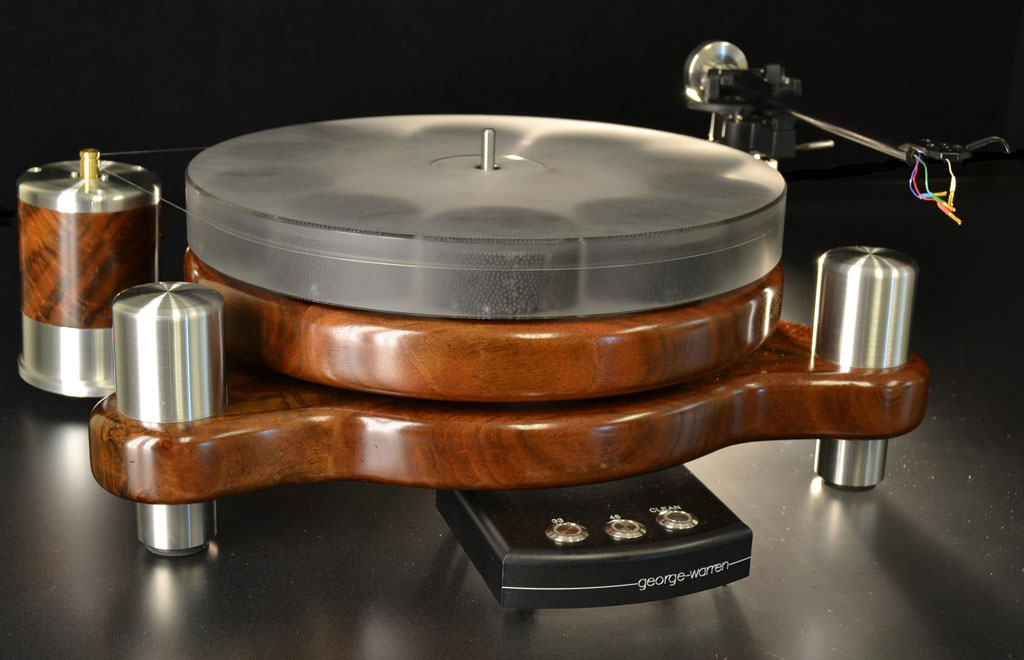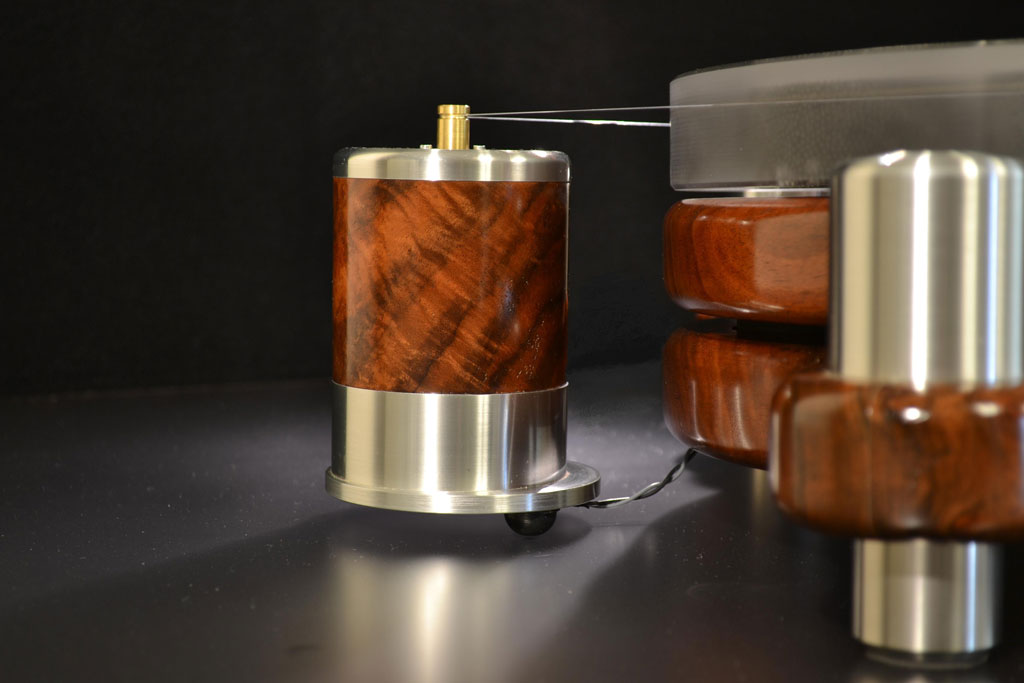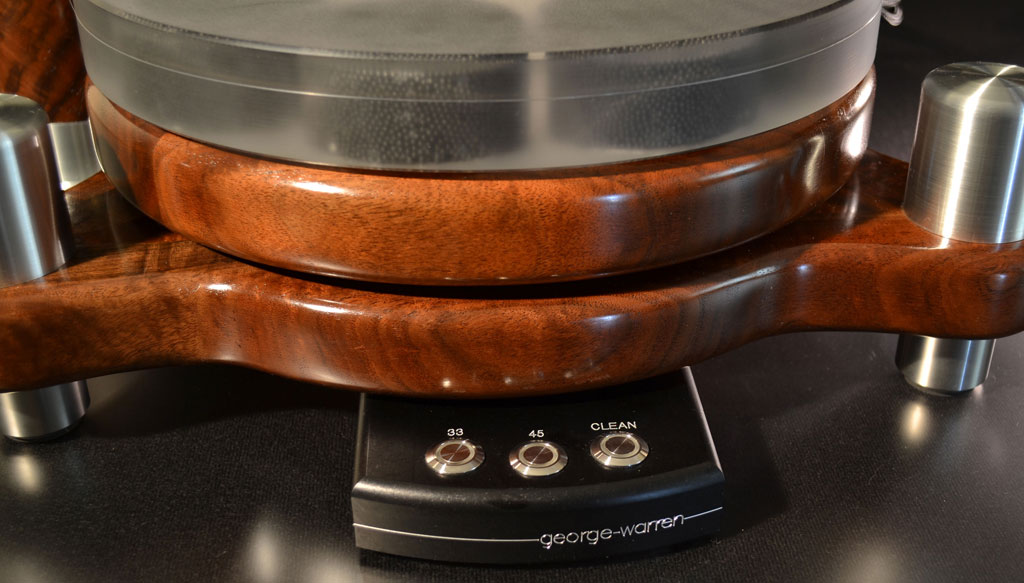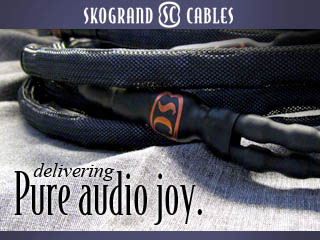Analog is truly the deepest rabbit hole in the audio yard. From table to tone-arm to cartridge to arm wire, there are a plethora of variables that go into making or breaking good analog sound. Not to mention some of the set up eccentricities imposed on the user by some of the more esoteric and complicated design choices.
The George Warren design goes a very long way in dispelling the anxiety that goes into the set up and operation of what has proven to be a very good, actually excellent, design.
My Table came in a beautiful, lightly stained figured walnut. The milling of the plinth with it’s rounded edges and rounded corners soften the overall look, while the brushed aluminum spring loaded footer towers give off just enough high-tek cred to the design. George Warren turntable bearing comprises a massive stainless steel spindle shaft. The spindle shaft sits in a sleeve of Ultra High Molecular Polyethylene, or UHMW, a high tech material that was developed just for this type of bearing application. It is called “the worlds strongest polymer”. The UHMW has a coefficient of friction close to that of Teflon and in addition is impregnated with a lubricant so it never needs to be lubricated. UHMW is much stronger and longer lasting in these types of applications then Teflon or Delrin.
The stainless steel spindle shaft sits on a UHMV button that in turn rests on a precision stainless steel bearing. Thanks to the UHMW sleeve and button, there is no metal to metal contact in this design and that makes for a very quiet, smooth turning platter. The whole structure is housed in a machined bronze housing that is fixed to the top plinth.
Further details include……..
Motor drive system
The George Warren turntable incorporates a DC motor drive system that starts with a very high quality Maxon DC motor. The power supply is 18 V. The motor is run by a control unit designed and manufactured specifically for the George Warren Turntable. There are three buttons on the controller unit: 33, 45 and Clean. The Clean function is to be used when cleaning the record on the platter. It bypasses the 33 and 45 circuitry and therefor eliminates the problem with the controller trying to maintain a precise speed with a cleaning brush presenting all that additional friction or load. When you are done cleaning, just press 33 or 45 and it will ramp down to that speed.
The controller takes direct feedback from the platter to control all functions. Feedback comes from a strobe pattern on the bottom of the platter that is read by a “Reflective Object Sensor”. When a function button is pushed the controller ramps up to speed, it may take 10 seconds or so to get to speed, then switches to run mode that maintain a precise and consistent speed during play and then ramps down and brakes the platter when the function button is pushed off.
Standard monofilment fishing line is used as the drive line. A light line, 4 or 6 lb. test is best. The smaller the diameter of the line, the smaller the knot. The line is double looped for better traction. The motor pod is a counterbalanced design that sets on two Sorbothane feet. When the line is strung around the platter and drive pulley on the motor and the motor pod is set upright, there will be exactly the right amount of tension on the drive line. The correct tension will be maintained at all times if the motor pod is upright. With a standard three or four point motor pod you can very easily put too much tension on the line, causing a greater lateral load on the bearing, or too little tension which caused the line to slip.
Tonearm
The standard tonearm provided with the George Warren Turntable is the Moth 301 with Incognito wiring. Arm boards can be provided for just about any type of arm a customer may want to put on.
Set up was a snap. Just follow the adequate instructions and even the most ham fisted of us can get the George Warren up and running. One warning, if you remove the platter, just be careful as the polymer button does not stick to the spindle. Mine did and fell off setting off a search and recover mission that lasted 45 minutes.
The acrylic platter has drilled out housings that hold equal numbers of buck shot offering greater mass and rotational consistency.
The control housing has 33 1/3, 45 and cleaning speeds. The cleaning speed while a good idea, in practice the disc slips and skids on the slick platter making cleaning less than optimal. Perhaps a platter matt would address this.
My Clearaudio Srtadavari cartridge was recently re tipped by Sound Smith and required a good deal of playing time. I played about 50 LP’s front and back to put some time on the cartridge. It did sound a little tight and bass shy at first, but this ultimately gave way to liquidity, extension and ease.
My early critical listening revealed something that I find really important in audio reproduction, though do not refer to as often as I should. Through the George Warren, music has purpose. There is a forward thrust, rhythmic drive, however you would like to refer to it, the George Warren Turntable has it-in spades. Phrasing, rhythmic drive propulsion, perhaps artistic intent? Just watch a musician in full throttle. There is serious musical intent written head to toe. The George Warren is just outstanding at communicating the timing cues many other front ends analog or digital flat out miss.
Along with this intense pace come wonderful tone and texture. Here’s where analog really sticks it to digital for the most part. Listening to Miles Davis on Kind A Blue, All Blues illustrates this nicely. This Classic Records 45 rpm pressing reveals great complexity in Miles’ muted horn. A muted horn especially in the higher registers can give an entire audio system a nervous breakdown. Next to the piano, this instrument can be one of the most difficult to get right. On many components the muted trumpet can be very dry and way too biting and glary. The George Warren maintains the elasticity in the sound, allowing the harmonics to stretch without snapping. The result is a sweetness that replaces the dryness.
Imaging is another analog strength. Listening to Spyro Gyro on the self titled album, there are a bunch of really cool sounding instruments, despite a dry top end. The first track features some really cool sounding vibes along with a liquid soaring sax. Each instrument is presented with a rare combination of intimacy and dynamic extension and control that did not cause instruments to leap off the stage. This adds to the sense that real instruments are in the room and maintain a stable image.
The bass is very good. Perhaps not as deep and rock solid as my Behold Transport can offer up, but again, the texture, tone and drive make up for it. Again, listening to Spyro Gyro the low bass was outstanding at starting and stopping with little overhang. This keeps the music really flowing in the right direction. There is great punch though not as gut wrenching as the Behold Transport. Perhaps another more ambitious arm would address this.
The George Warren was more than capable at unraveling studio recordings such as Ozzy Ozbournes “I don’t know” from Diary of a Mad Man featuring some of Randy Rhodes’ finest guitar work. Randy’s untimely death in 1982 cut short a career that was sure to be legendary even among legends. His swirling and whirling chorus effects are laid bare as are the echoes and reverb effects which are applied with some abandon. I had no idea how much I was missing listening to these cuts through my iPhone. The size of the acoustic, though electronically fabricated is absolutely huge, blooming into the room with effortlessness and clarity. (I love my iPhone and use it religiously when I’m out of the house. But let’s be clear, it is not high end.)
On the slightly drier side of the recording art is Robin Trower’s Bridge of Sighs. The underappreciated guitarist performs some of the finest blues inspired rock you will find anywhere. The recording is very good with an upfront presentation that lends great insight into the trio’s performance. Through the George Warren, the presentation is a touch more laid back than through my Behold Transport and DAC. The digital presentation is drier with the sound of the squeaky bass drum pedal more prominent in the mix. The analog version is a bit less dry, and slightly narrower in perspective. Both have their charms and it is nice to be able to pick my poison depending on my mood. Tonally, the George Warren is a touch warmer, emphasizing the mid band. This really allows the melody to come to the front and musically communicate.
Conclusion
Given the state of analog in the high end, there are many entry level priced tables available from a plethora of companies. Many have gotten favorable reviews through the press. So, it is possible to enjoy analog even at the sub $2,000 level. At $4,850 for the walnut version that I was sent, the George Warren turntable occupies the starting point for a truly artisanal approach. Produced in limited quantities and possessing a fine sculptural appeal, the George Warren table offers more than a touch of far more expensive designs in both feel and performance.
It has been a real privilege to spend this time with the George Warren Turntable. Combing through my hundreds of albums, finding something special, dropping it on the platter and settling in for a good twenty minutes of music while perusing the liner notes, is like nothing that the digital realm has.
Of course it cannot be all about nostalgia, and gratefully, the sound offered up by the George Warren is very contemporary and reference level in many ways.
Pace, rhythm and timing keeps the music flowing. Texture and tone keep the ears peeled. Depending on the recording, solid imaging and presence make for a “you are there” or “they are here” experience. That is what the High End is all about..
- (Page 1 of 1)






I have no experience with this table, but have used fishing line in a previous table I owned. I found that when the knot passed the motor spindle a slight vibration could be felt that could be transmitted to the platter. The bigger the knot the bigger the vibration. It just seems to me that a continuous line without a knot is a better design.
I was concerned at first, but there was no “Blip” or Knot induced nasties that I could detect.
Best,
Greg